<< Previous | Displaying results 4451-4500 of 6769 for "" | Next >>
After word reached America of the Nazi killing of European Jewry, pressure mounted on the Roosevelt administration to help European Jews. To spur action, playwright Ben Hecht prepared a memorial to the Jewish victims of Nazi persecution, "We Will Never Die." The pageant, sponsored by the Zionist Revisionist Bergson Group, was part of a mass demonstration at Madison Square Garden in New York City. Later seen in other US cities, the show was part of the Bergson Group's effort to pressure Washington to act…
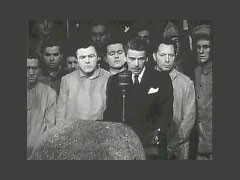
The Germans invaded the Soviet Union in June 1941 (Operation "Barbarossa"). German forces occupied Vitebsk in the northeastern region of Belorussia on July 11. Soviet forces seized the initiative from the Germans after the battle of Stalingrad in late 1942 and early 1943. The Soviet army liberated Vitebsk on June 26, 1944, during their summer 1944 offensive. This footage shows military units involved in the fighting and German soldiers captured during the campaign. By the end of the summer, the Soviet…
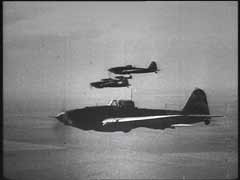
In June 1944, the Soviet Union launched a massive offensive against the German army in eastern Europe. Soviet forces reoccupied Vilna in July 1944, after bitter street fighting with the German garrison. They then continued on toward Kovno, the capital of Lithuania. This Soviet footage depicts the battle for Vilna and the final reoccupation of the city by the Soviet army.

After the sudden death of Franklin D. Roosevelt in April 1945, Vice President Harry S. Truman became president of the United States. Here, President Truman meets with the heads of state of the Soviet Union and Great Britain (Joseph Stalin, Winston S. Churchill, and later Clement Attlee) in Potsdam, near Berlin, to discuss the future of defeated Germany. The leaders agreed to the partition of Germany and Berlin, Germany's capital city, into four zones of occupation: British, French, American, and Soviet.…
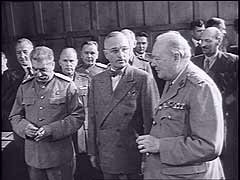
The Buchenwald camp was one of the largest concentration camps. The Nazis built it in 1937 in a wooded area northwest of Weimar in central Germany. US forces liberated the Buchenwald camp on April 11, 1945. When US troops entered the camp, they found more than 20,000 prisoners. This footage shows scenes that US cameramen filmed in the camp, survivors, and the arrival of Red Cross trucks.
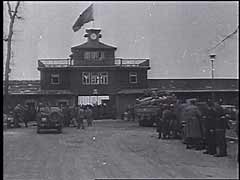
US forces liberated the Buchenwald concentration camp in Germany in April 1945. Here, US soldiers escort German civilians from the nearby town of Weimar through the Buchenwald camp. The American liberating troops had a policy of forcing German civilians to view the atrocities committed in the camps.
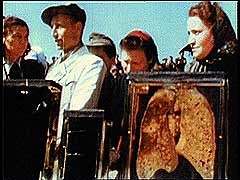
US forces liberated the Buchenwald concentration camp on April 11, 1945. This footage records examples of Nazi atrocities (shrunken head, pieces of tattooed human skin, preserved skull and organs) discovered by the liberating troops.
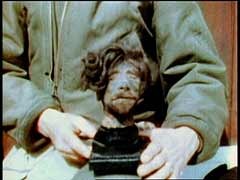
This footage shows Joseph Goebbels, Nazi minister for propaganda and public education, speaking at the September 1935 Nazi Party Congress in Nuremberg. In the speech, Goebbels--a fanatic antisemite--linked Bolshevism with international Jewry and warned Nazi party members of an alleged international Jewish conspiracy to destroy western civilization. Goebbels led the purge of Jewish and other so-called "un-German" influences from the cultural institutions of Nazi Germany.
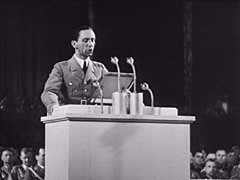
In response to growing international awareness of Nazi atrocities, the Nazis decided to allow a Red Cross investigation committee to visit the Theresienstadt ghetto in Czechoslovakia. Elaborate measures were taken to disguise conditions in the ghetto and to portray an atmosphere of normalcy. This footage, showing an orchestral performance, is part of a German propaganda film made following the Red Cross visit to Theresienstadt.
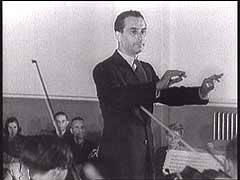
This footage shows German forces entering the Sudetenland. Under the terms of the Munich Pact, Germany annexed this largely German-speaking region from Czechoslovakia. Germany, Italy, Britain, and France were party to the pact, which averted war. Czechoslovakia, however, was not permitted to attend the Munich conference. Hitler later violated the Munich Pact by destroying the Czech state in March 1939.
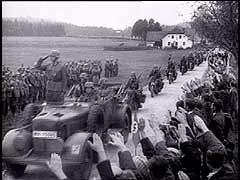
The Treaty of Versailles, imposed on Germany following its defeat in World War I, declared Danzig to be a free city jointly administered by Poland and the League of Nations. Germany bitterly resented the loss of this largely German city, which was also an important port on the Baltic Sea. The return of Danzig to Germany became a central focus of Adolf Hitler's foreign policy. Germany invaded Poland in September 1939. After the invasion of Poland, Germany unilaterally annexed Danzig. This German newsreel…
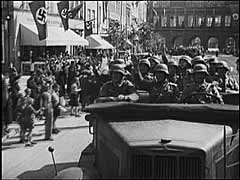
In this German newsreel footage, Hitler addresses members of the SA and the SS in the Sportpalast, a sports arena in Berlin, Germany. He thanks them for their support and sacrifice during the Nazi struggle for power.
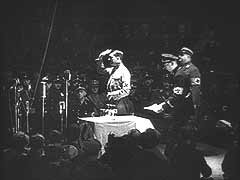
This footage shows the Reichstag (German parliament) building on the day after it was set on fire. While the origins of the fire on February 27 are still unclear, Hitler blamed Communists for the incident. The Reichstag Fire Decree of February 28, 1933, suspended constitutional guarantees. Communist and Socialist deputies were expelled from the parliament. Shortly after the decree was issued, the Nazis established concentration camps for the internment of political opponents.
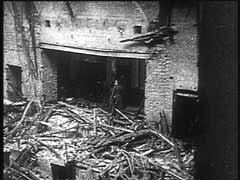
On the night of February 27, 1933, an unemployed Dutch construction worker named Marinus van der Lubbe set fire to the Reichstag (German parliament) building, causing serious damage. The Nazis blamed the Communists for the fire and claimed emergency powers to crush all opposition. Bolstering Nazi claims, the police also arrested three Bulgarian members of the Communist International, who were in Germany at the time, and a leading German Communist. Despite Nazi claims, however, responsibility for the fire…

Denmark signed a nonaggression pact with Germany in 1939, hoping to maintain neutrality as it had in World War I. Germany, however, broke the agreement on April 9, 1940, when it occupied Denmark. King Christian X remained on the throne, and the Danish police and government reluctantly accepted the German occupation. This footage shows the German presence in the occupied Danish capital, Copenhagen. In 1943, as German policies towards Denmark toughened, the Danes would form one of the most active and…
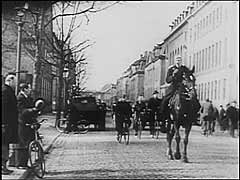
During World War II , the American Friends Service Committee, a Quaker relief organization, provided food, shelter, and other aid to thousands of Jewish refugees—especially Jewish children—in France. The Quakers were active throughout France, even in areas occupied by German forces. In this footage, Quaker relief workers feed children at one of the Quaker-established schools in Marseille in the unoccupied southern zone of France.
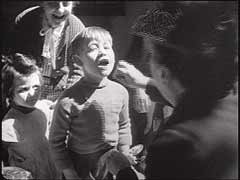
The Dachau concentration camp, northwest of Munich, Germany, was the first regular concentration camp the Nazis established in 1933. About twelve years later, on April 29, 1945, US armed forces liberated the camp. There were about 30,000 starving prisoners in the camp at that time. The film seen here was edited from original footage shot by Allied cameramen as liberating troops entered Dachau. It was discovered in the archives of the Imperial War Museum in 1984 and was never completed.
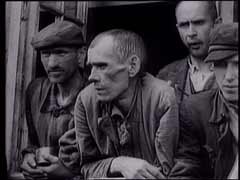
The Dachau concentration camp, northwest of Munich, Germany, was the first regular concentration camp the Nazis established in 1933. About twelve years later, on April 29, 1945, US armed forces liberated the camp. There were some 30,000 starving prisoners in the camp at that time. In this footage, soldiers of the US Seventh Army feed and disinfect survivors of the camp.
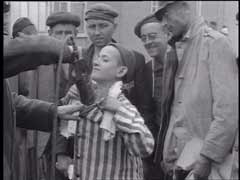
US forces liberated the Dachau concentration camp in Germany in April 1945. Here, survivors of the camp stand during the singing of "Hatikva" ("Hope") before Rabbi David Eichhoren, a US army chaplain, leads one of the first Jewish prayer services after liberation.
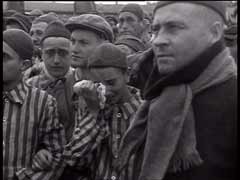
About a million Roma (Gypsies) lived in Europe before World War II. The largest Romani community—of about 300,000—was in Romania. This film shows a Romani (Gypsy) community in Moreni, a small town northwest of Bucharest. Many Roma led a nomadic lifestyle and often worked as small traders, craftsmen, merchants, laborers, and muscians.
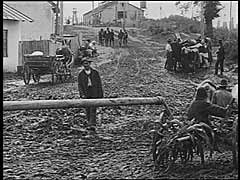
This film excerpt from Groß-Stadt Zigeuner (1932) by filmmaker László Moholy-Nagy shows a Romani (Gypsy) campsite near Berlin, Germany, in the last year of the Weimar Republic. Although Roma (Gypsies) had faced persecution in Germany even before the Nazi rise to power in 1933, the Nazis regarded them as racial enemies to be identified and killed. Tens of thousands of Roma were killed by the Einsatzgruppen in eastern Europe or were deported to killing centers in occupied Poland.
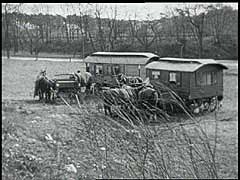
Germany and its Axis allies invaded Yugoslavia in April 1941. The Germans probably shot this film after they occupied southern Slovenia following the Italian armistice in 1943. The film was found in the Ustasa (Croatian fascist) archives after World War II and shows the dismal living conditions that Roma (Gypsies) endured in occupied northern Yugoslavia.
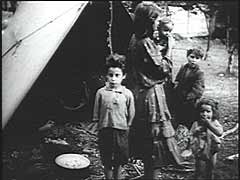
This breakfast menu comes from the SS Exeter, an American ocean liner. The ship carried the Shadurs, a Jewish refugee family, to the United States in February-March 1941. The Shadurs were among the many Jewish refugees who journeyed on the SS Exeter from Lisbon, Portugal, to New York during World War II. Joseph Shadur was twelve years old at the time. He marveled at the ship’s bountiful meals, especially in light of the hunger his family had faced on their journey to the port of Lisbon. The course of…

Between World War I and World War II, dozens of synagogues and prayer houses served the religious needs of Lwów’s diverse Jewish community. This postcard from around 1917 shows the Progressive Synagogue, also known as the Temple, in Lwów. Built in the 1840s and originally named the German-Israelite Prayer House, it served the city’s progressive Jewish community. From 1904, the synagogue’s rabbi regularly preached in Polish. The Nazis destroyed the synagogue in 1941.

After British soldiers liberated the Bergen-Belsen concentration camp in Germany, they forced the remaining SS guards to help bury the dead. Here, survivors of the camp taunt their former tormentors, who prepare to bury victims in a mass grave.
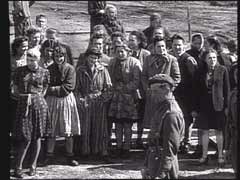
As Allied forces approached Germany in late 1944 and early 1945, Bergen-Belsen became a collection camp for tens of thousands of prisoners evacuated from camps near the front. Thousands of these prisoners died due to overcrowding, poor sanitary conditions, and lack of adequate food and shelter. On April 15, 1945, British soldiers entered Bergen-Belsen. They found about 55,000 prisoners in the camp, most in a critical condition. This footage shows Allied cameramen filming the condition of the prisoners and…

The Storm Troopers (SA) established the Oranienburg camp near Berlin in March 1933. The first prisoners were German political prisoners, primarily Communists and Social Democrats. Oranienburg became known for the maltreatment of inmates. Here, the Nazis attempt to undermine the charges of brutality by showing the "normal" prisoner routine. Oranienburg was gradually deactivated, closing by 1935. Most of the other early camps were also closed, to be replaced with larger camps run by the SS.
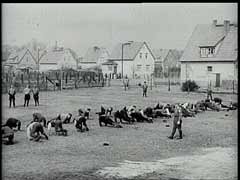
Soldiers of the Jewish Brigade, British Eighth Army, in the Faenza area of Italy. The Jewish Brigade took part in the final stages of the Allied offensive in Italy.
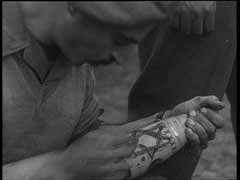
Members of a German Zionist youth group learn farming techniques in preparation for their new lives in Palestine. Many Jewish youths in Nazi Germany participated in similar programs, hoping to escape persecution by leaving the country.
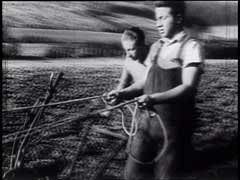
US forces liberated the Dora-Mittelbau (Nordhausen) concentration camp in April 1945. Here, medics and soldiers of the US 3rd Armored Division evacuate sick and dying survivors of the camp.
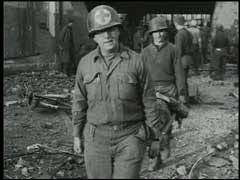
The Junkers (Ju) 87, known as the "Stuka," spearheaded the Blitzkrieg ("lightning war") attacks that were decisive in the western campaign in 1940. Stuka dive-bombers closely supported German ground forces. They destroyed enemy strong points, aircraft, and airfields, and spread panic in rear areas. Although slow and easily shot down by Allied fighters, the Stukas proved devastatingly effective in the German invasions of Poland and western Europe, where Germany enjoyed superiority in the air. Stukas caused…
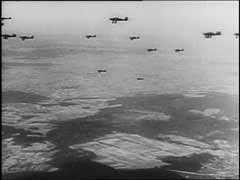
The German ship SS "St. Louis" departed from Hamburg for Cuba with almost 1,000 Jewish refugees on board on May 13, 1939. Most of the passengers had Cuban landing certificates. However, the Cuban government invalidated the certificates. When the "St. Louis" reached Havana on May 27, most of its passengers were denied entry. After the United States also refused to accept the refugees, the ship returned to Europe, docking at Antwerp. Britain, France, Belgium, and the Netherlands then agreed to accept the…
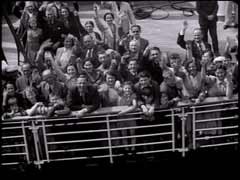
Roma (Gypsies) celebrate with music, dancing, and singing in the mountains near Zagreb, Yugoslavia. During World War II, Roma in Yugoslavia were exterminated by Croatian nationalists and by the Germans.
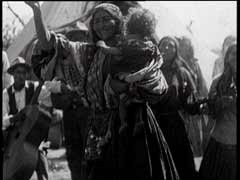
In July 1947, 4,500 Jewish refugees left displaced persons camps in Germany and boarded the "Exodus 1947" in France. They attempted to sail to Palestine although they did not have permission from British authorities to land. The British intercepted the ship and forcibly returned the Jewish refugees to Germany. Here, Jews from the "Exodus 1947" are confined in Poppendorf, Germany. The plight of the "Exodus" passengers became a symbol of the struggle for open Jewish emigration to Palestine.
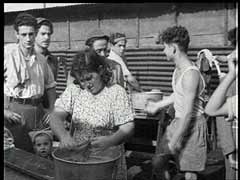
In July 1947 in France, 4,500 Jewish refugees from displaced persons camps in Germany boarded the "Exodus 1947" and attempted to sail (without permission to land) to Palestine, which was under British mandate. The British intercepted the ship off the coast and forced it to anchor in Haifa, where British soldiers removed the Jewish refugees. After British authorities failed to force France to accept the refugees, the refugees were returned to DP camps in Germany. The plight of the "Exodus" passengers became…
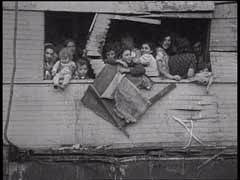
In July 1947, 4,500 Jewish refugees left displaced persons camps in Germany and boarded the "Exodus 1947" in France. They attempted to sail to Palestine without, however, having British permission to land. The British intercepted the ship and forcibly returned the refugees to Germany. This footage shows a protest in the Bergen-Belsen displaced persons camp in the British occupation zone of Germany. The protesters denounced British treatment of the "Exodus 1947" passengers. The plight of the "Exodus"…
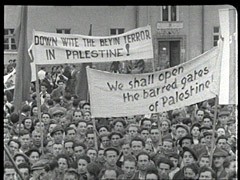
France signed an armistice with Germany on June 22, 1940, recognizing the right of German authorities to oversee the French administration. Further, German military authorities held jurisdiction over matters of internal security. In this footage, a German military court in Paris tries French citizens charged with resisting measures of the military occupation. Despite harsh military justice, the Germans could not quell opposition in France, and resistance activities would reach a peak during the Allied…

Czech resistance fighters attacked Reinhard Heydrich, acting governor of the Protectorate of Bohemia and Moravia, in an ambush near Prague in May 1942. Heydrich died of his wounds on June 4, 1942. In retaliation for the attack, the Germans destroyed the village of Lidice on June 10, 1942. The Germans shot all the men in the village and deported most of the women and children to camps in Germany. This footage shows destroyed homes and German officials inspecting the remains of the village.
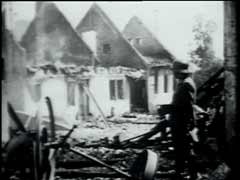
At his hidden headquarters in the mountains of Yugoslavia, Marshal Tito (Josip Broz), head of the Yugoslav Communist partisan movement, prepares his forces for battle. Women gather silk parachutes, used to drop supplies by Allied forces, for use as bandages. Partisans train, preparing to fight the Germans. At the height of the partisan war in Yugoslavia in 1943, Tito's partisans engaged some 35 Axis divisions, which otherwise might have been in service on the Italian or eastern fronts.
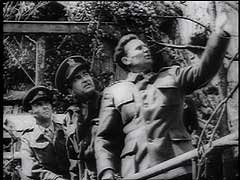
Germany invaded the Netherlands on May 10, 1940. Four days later, German planes bombed Rotterdam. The Germans tried to halt the raid on the city because Dutch authorities had agreed to negotiate the surrender of their country. However, a communications failure delayed the order halting the attack. The bombing destroyed much of the city center, leaving almost 80,000 people homeless. The Netherlands surrendered just a few hours later. On May 15, in retaliation for the bombing of Rotterdam, the British air…
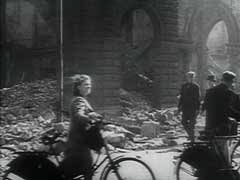
The Junkers (Ju) 87, known as the "Stuka," spearheaded the Blitzkrieg ("lightning war") attacks that were decisive in the western campaign in 1940. Stuka dive-bombers closely supported German forces on the ground. They destroyed enemy strong points, aircraft, and airfields, and spread panic in rear areas. Although slow and easily shot down by Allied fighters, the Stukas proved devastatingly effective in the German invasions of Poland and western Europe, where Germany enjoyed air superiority. Stuka…
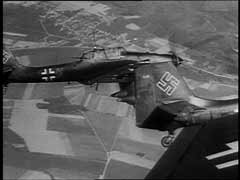
The Treaty of Versailles, imposed on defeated Germany following World War I, declared Danzig to be a free city jointly administered by Poland and the League of Nations. Germany bitterly resented the loss of this largely German city, which was also an important port on the Baltic Sea. The return of Danzig became a central feature of Adolf Hitler's foreign policy. This footage shows pro-German forces besieging a Polish garrison in Danzig's main post office. Germany annexed Danzig after the defeat of Poland…
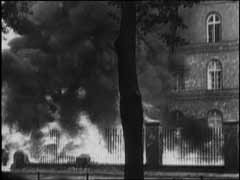
German troops entered Austria on March 12, 1938. The annexation of Austria to Germany was proclaimed on March 13, 1938. In this German newsreel footage, Austrians express overwhelming enthusiasm for the Nazi takeover of their country.
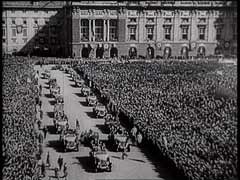
[This video is silent] An agreement signed at the Munich conference of September 1938 ceded the German-speaking Sudetenland region of Czechoslovakia to Germany. The agreement was reached between Germany, Italy, Britain, and France. Czechoslovakia was not permitted to attend the conference. In March 1939, six months after signing the Munich agreement, Hitler violated the agreement and destroyed the Czech state.
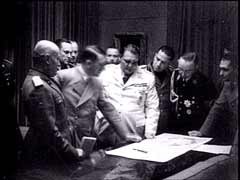
In an attempt to prevent the German annexation of Austria, Austrian chancellor Kurt von Schuschnigg called a plebiscite (referendum) on Austrian independence. On March 11, 1938, the Germans pressured Schuschnigg to cancel the plebiscite and resign. This German newsreel footage from March and April 1938 served as propaganda for the Nazi annexation of Austria. It begins with images of pro-Nazi residents in Graz expressing their opposition to Schuschnigg's plebiscite. It also includes footage after…
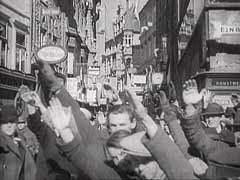
US forces under the command of General Omar Bradley reached the Ebensee forced-labor camp in Austria in early May 1945. The Germans had built Ebensee at the foot of the Austrian Alps as part of the Mauthausen system of camps. The Nazis employed Ebensee prisoners as forced laborers during the construction of an underground rocket factory. Thousands died from the harsh conditions and back-breaking labor.
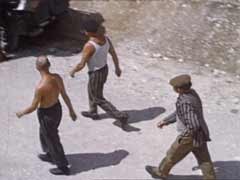
The Mauthausen concentration camp was established shortly after the German annexation of Austria (1938). Prisoners in the camp were forced to perform crushing labor in a nearby stone quarry and, later, to construct subterranean tunnels for rocket assembly factories. US forces liberated the camp in May 1945. In this footage, starving survivors of the Mauthausen concentration camp eat soup and scramble for potatoes.
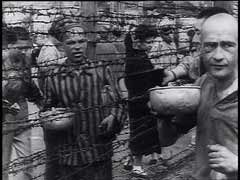
Estonian auxiliary forces assisted the German Einsatzgruppen (mobile killing units) in the mass killing of Jews and others during World War II. Ralf Gerrets and Jaan Viik were both members of the Estonian security police during the German occupation. This footage shows them during their trial, on charges of war crimes, in the Estonian Soviet Socialist Republic. The Estonian Supreme Court found both guilty and sentenced them to death in 1961.

Jews were deported from Kavala, Seres, and Drama in Bulgarian-occupied Thrace. Some 3,000 Jews were taken to Drama and herded onto trains without food or water for transport to a camp in Gorna Dzumaya. The Jews were probably then taken to the Bulgarian port of Lom on the Danube River, where they boarded ships for Vienna. From there, the Nazis deported them to the Treblinka killing center.
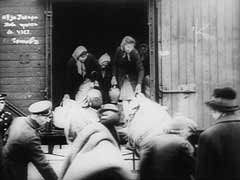
One day after France signed an armistice with Germany in June 1940, Adolf Hitler celebrated the German victory over France with a tour of Paris. Here, Hitler's train arrives in Paris. Hitler's tour included the Paris opera, the Champs-Elysees, the Arc de Triomphe, and the Eiffel Tower. After visiting Napoleon's tomb and the Sacre Coeur, Hitler left Paris. In all, Hitler spent about three hours in the city. In July, Hitler returned in triumph to Berlin, Germany.
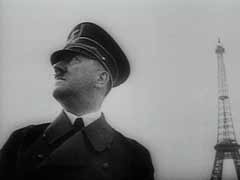
We would like to thank Crown Family Philanthropies, Abe and Ida Cooper Foundation, the Claims Conference, EVZ, and BMF for supporting the ongoing work to create content and resources for the Holocaust Encyclopedia. View the list of donor acknowledgement.